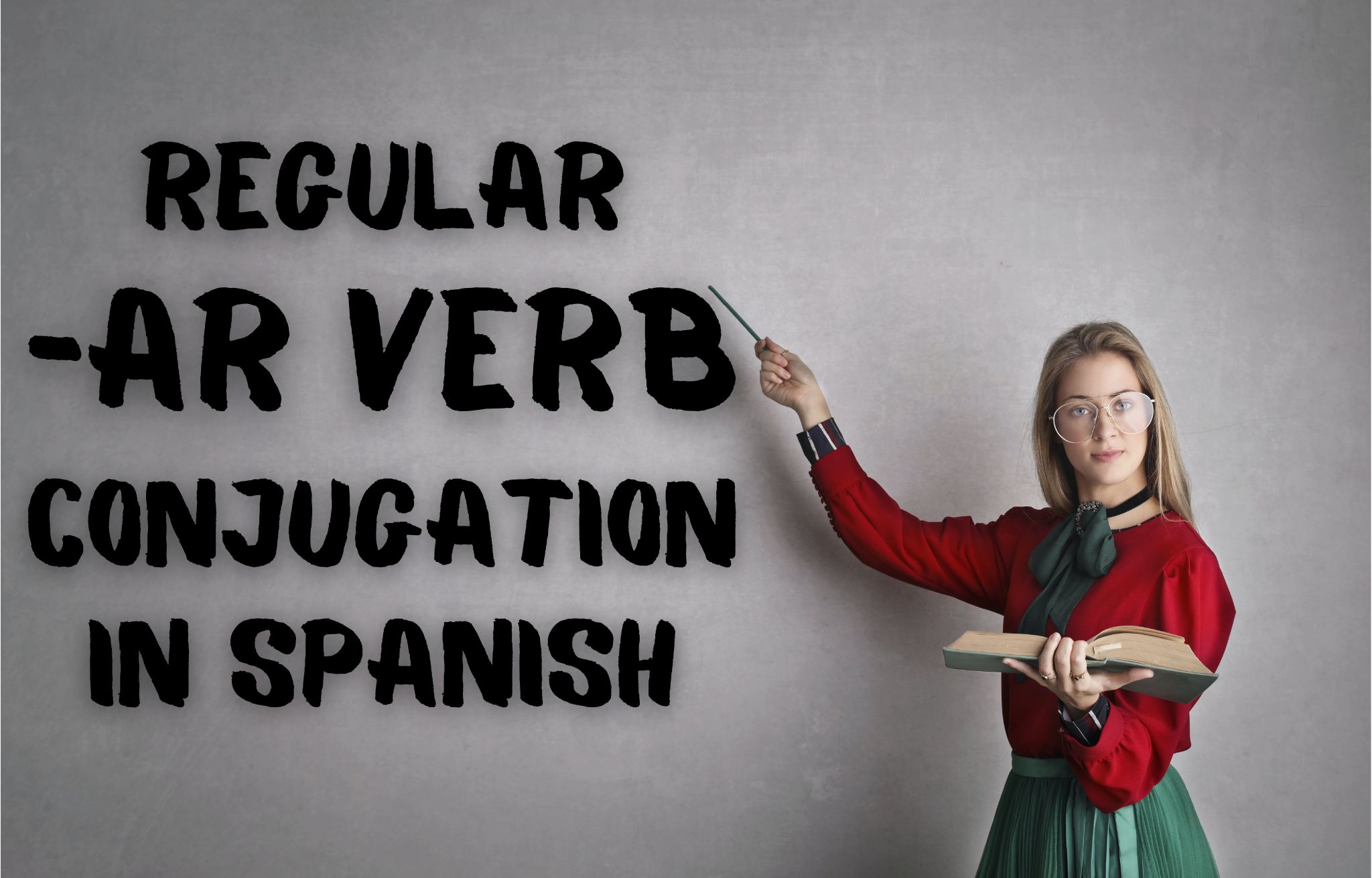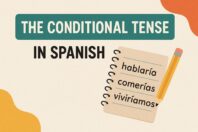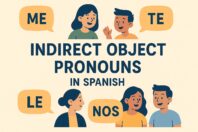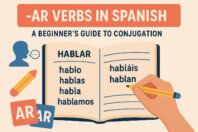Spanish AR verb conjugation: All endings for regular AR verbs

Get our free email course, Shortcut to Conversational.
Have conversations faster, understand people when they speak fast, and other tested tips to learn faster.
More infoAre you looking for a quick reference to Spanish -ar verb conjugation? In this post, we’ll provide the -ar conjugation chart for every single tense. We’ll show all of the -ar endings, and demonstrate each -ar conjugation with typical regular -ar verbs in Spanish.
In Spanish, we can divide all our verbs into three main groups: -ar verbs, -er verbs, and -ir verbs. Most verbs within each group follow the same regular conjugation patterns, so once you’ve learned these three sets of conjugations, you can apply the same pattern to any other regular verb in that group.
Many verbs follow slightly different conjugation patterns, so these variants need to be learned separately. Still, these irregular conjugations usually only differ in a couple of places, and in a couple of tenses. The majority of conjugations, even for irregular verbs, follow the regular patterns of their group.
Spanish AR verb conjugation
In today’s post we’ll focus specifically on the conjugation patterns for regular -ar verbs in Spanish. We recognize these in their infinitive form as verbs ending in -ar. In Spanish, conjugation for this group of verbs is known as the primera conjugación.
We’ll provide the -ar conjugation chart for each tense. We’ll break the tenses down by mood, presenting the simple tenses and the perfect tenses for each. In every tense, we’ll first show the -ar verb endings in Spanish, and then we’ll demonstrate them in action with a sample regular -ar verb conjugation. We’ll use a different regular -ar verb every time, always highlighting the -ar verb’s ending in each example.
At the end of the post, we’ll include a list of the most common regular -ar verbs in Spanish that follow the conjugation patterns we present here, followed by example sentences where we conjugate each one. We also recommend our related post with the 44 most common -ar verbs in Spanish.
Remember that the conjugations we’re presenting here are for regular -ar verbs in Spanish. For an introduction to irregular conjugations, check out our posts on stem-changing verbs, yo -go verbs, and irregular preterite verbs. We also have a number of posts on specific irregular verbs such as ser, estar, and ir.
We’ll provide links to other lessons specific to the various tenses as we get to them, or you can take a look at our big overview post that introduces every Spanish verb tense.
Now let’s get started with our -ar verbs conjugation!
Impersonal forms
Before we get into the tenses, let’s just cover the impersonal verb forms. As our sample -ar verb for these forms we’ll use the verb tomar, meaning to take or to drink.
| impersonal form | ending | tomar |
| infinitive | -ar | tomar |
| gerund | -ando | tomando |
| participle | -ado | tomado |
| perfect infinitive | haber -ado | haber tomado |
| perfect gerund | habiendo -ado | habiendo tomado |
Indicative mood
We’ll start off with the -ar conjugation charts in the Spanish indicative mood.
Present AR verb conjugation
To demonstrate the present indicative tense in Spanish, we’ll use the sample -ar verb amar, which means to love.
| subject | present -ar verb endings | amar |
| yo | -o | amo |
| tú | -as | amas |
| él, ella, usted | -a | ama |
| nosotros, nosotras | -amos | amamos |
| vosotros, vosotras | -áis | amáis |
| ellos, ellas, ustedes | -an | aman |
Imperfect AR verb conjugation
Now let’s see the regular -ar conjugation chart for the Spanish imperfect tense. Here we’ll use cantar, meaning to sing, as our sample -ar verb.
| subject | imperfect -ar verb endings | cantar |
| yo | -aba | cantaba |
| tú | -abas | cantabas |
| él, ella, usted | -aba | cantaba |
| nosotros, nosotras | -ábamos | cantábamos |
| vosotros, vosotras | -abais | cantabais |
| ellos, ellas, ustedes | -aban | cantaban |
Preterite AR verb conjugation
Now we’ll learn the regular -ar verb conjugation for the preterite past tense, in contrast to the imperfect past. See our post on the “acabar de” hack for the other easy way to talk about the immediate past.
We’ll demonstrate this tense using comprar, meaning to buy.
Note that the first-person plural (nosotros/nosotras) preterite conjugation for -ar verbs is identical to that of the present tense we saw above.
| subject | preterite -ar verb endings | comprar |
| yo | -é | compré |
| tú | -aste | compraste |
| él, ella, usted | -ó | compró |
| nosotros, nosotras | -amos | compramos |
| vosotros, vosotras | -asteis | comprasteis |
| ellos, ellas, ustedes | -aron | compraron |
Future AR verb conjugation
The last simple tense we’ll cover in the indicative is the Spanish future tense. For a simpler way to talk about the future, we recommend our post on the “voy a” hack.
We’ll use viajar as our example verb here, meaning to travel.
| subject | future -ar verb endings | viajar |
| yo | -aré | viajaré |
| tú | -arás | viajarás |
| él, ella, usted | -ará | viajará |
| nosotros, nosotras | -aremos | viajaremos |
| vosotros, vosotras | -aréis | viajaréis |
| ellos, ellas, ustedes | -aran | viajaran |
Present perfect AR verb conjugation
Now let’s get into the compound tenses in the indicative mood, starting with the present perfect tense, or pretérito perfecto. Since the compound conjugations are all built around the participle, the only thing that changes in these tenses is the conjugation of the auxiliary verb haber.
We’ll demonstrate our compound conjugations with the sample verb pintar, meaning to paint, whose participle is pintado.
| subject | present perfect -ar verb endings | pintar |
| yo | he -ado | he pintado |
| tú | has -ado | has pintado |
| él, ella, usted | ha -ado | ha pintado |
| nosotros, nosotras | hemos -ado | haemos pintado |
| vosotros, vosotras | habéis -ado | habéis pintado |
| ellos, ellas, ustedes | han -ado | han pintado |
Past perfect AR verb conjugation
Next, we’ll see the past perfect conjugation of -ar verbs. This tense is called pretérito pluscuamperfecto in Spanish.
| subject | past perfect -ar verb endings | pintar |
| yo | habia -ado | habia pintado |
| tú | habías -ado | habías pintado |
| él, ella, usted | había -ado | había pintado |
| nosotros, nosotras | habíamos -ado | habíamos pintado |
| vosotros, vosotras | habíais -ado | habíais pintado |
| ellos, ellas, ustedes | habían -ado | habían pintado |
Anterior perfect AR verb conjugation
This tense, known as the pretérito anterior in Spanish, is pretty much obsolete. We’re including it here for completeness. We’ll just keep using pintar as the example -ar verb, since the only thing that changes here is the auxiliary verb.
| subject | anterior perfect -ar verb endings | pintar |
| yo | hube -ado | hube pintado |
| tú | hubiste -ado | hubiste pintado |
| él, ella, usted | hubo -ado | hubo pintado |
| nosotros, nosotras | hubimos -ado | hubimos pintado |
| vosotros, vosotras | hubisteis -ado | hubisteis pintado |
| ellos, ellas, ustedes | hubieron -ado | hubieron pintado |
Future perfect AR verb conjugation
The final -ar conjugation chart we’ll look at in the indicative mood is the perfect future tense.
| subject | future perfect -ar verb endings | pintar |
| yo | habré -ado | habré pintado |
| tú | habrás -ado | habrás pintado |
| él, ella, usted | habrá -ado | habrá pintado |
| nosotros, nosotras | habremos -ado | habremos pintado |
| vosotros, vosotras | habréis -ado | habréis pintado |
| ellos, ellas, ustedes | habrán -ado | habrán pintado |
Conditional mood
The conditional tenses in Spanish are generally still considered to fall within the indicative mood, but for our purposes of conjugation we’ll present them here in their own section.
Simple conditional AR verb conjugation
To demonstrate our regular -ar verb conjugation in the conditional, we’ll use cortar as our example verb. It means to cut.
| subject | conditional -ar verb endings | cortar |
| yo | -aría | cortaría |
| tú | -arías | cortarías |
| él, ella, usted | -aría | cortaría |
| nosotros, nosotras | -aríamos | cortaríamos |
| vosotros, vosotras | -aríais | cortaríais |
| ellos, ellas, ustedes | -arían | cortarían |
Perfect conditional AR verb conjugation
We’ll continue to use cortar as our example -ar verb for the compound conditional conjugations, with its participle cortado.
| subject | perfect conditional -ar verb endings | cortar |
| yo | habría -ado | habría cortado |
| tú | habrías -ado | habrías cortado |
| él, ella, usted | habría -ado | habría cortado |
| nosotros, nosotras | habríamos -ado | habríamos cortado |
| vosotros, vosotras | habríais -ado | habríais cortado |
| ellos, ellas, ustedes | habrían -ado | habrían cortado |
Subjunctive mood
Now we’re ready to get into the conjugations of Spanish -ar verbs in the subjunctive mood. We’ll cover every tense here, including the archaic ones.
Present subjunctive AR verb conjugation
We’ll start with the most common tense in this mood, the present subjunctive. We’ll use trabajar as our example verb here, which means to work.
| subject | present subjunctive -ar verb endings | trabajar |
| yo | -e | trabaje |
| tú | -es | trabajes |
| él, ella, usted | -e | trabaje |
| nosotros, nosotras | -emos | trabajemos |
| vosotros, vosotras | -éis | trabajéis |
| ellos, ellas, ustedes | -en | trabajen |
Imperfect subjunctive AR verb conjugation
There are two acceptable sets of verb endings in the imperfect subjunctive tense, so we’ll include them both here. Either one is considered correct. As our example verb, we’ll use hablar, which means to speak or to talk.
| subject | imperfect subjunctive -ar verb endings | hablar |
| yo | -ara / -ase | hablara / hablase |
| tú | -aras / -ases | hablaras / hablases |
| él, ella, usted | -ara / -ase | hablara / hablase |
| nosotros, nosotras | -áramos / -ásemos | habláramos / hablásemos |
| vosotros, vosotras | -arais / -aseis | hablarais / hablaseis |
| ellos, ellas, ustedes | -aran / -asen | hablaran / hablasen |
Present perfect subjunctive AR verb conjugation
Here’s our first compound subjunctive tense, known in Spanish as the pretérito perfecto subjuntivo. We’ll continue using hablar as the typical -ar verb, with its participle hablado.
| subject | present perfect subjunctive -ar verb endings | hablar |
| yo | haya -ado | haya hablado |
| tú | hayas -ado | hayas hablado |
| él, ella, usted | haya -ado | haya hablado |
| nosotros, nosotras | hayamos -ado | hayamos hablado |
| vosotros, vosotras | hayáis -ado | hayáis hablado |
| ellos, ellas, ustedes | hayan -ado | hayan hablado |
Past perfect subjunctive AR verb conjugation
Now we’ll see the last of the subjunctive tenses you’re ever likely to come across, the pretérito pluscuamperfecto subjuntivo. Like its simple counterpart above, this compound tense also has two correct forms. We’ll include both possible conjugations of the auxiliary verb here, either of which can preced the participle. We’ll continue using the past participle of hablar: hablado
| subject | past perfect subjunctive -ar verb endings | hablar |
| yo | hubiera / hubiese -ado | hubiera / hubiese hablado |
| tú | hubieras / hubieses -ado | hubieras / hubieses hablado |
| él, ella, usted | hubiera / hubiese -ado | hubiera / hubiese hablado |
| nosotros, nosotras | hubiéramos / hubiésemos -ado | hubiéramos / hubiésemos hablado |
| vosotros, vosotras | hubierais / hubieseis -ado | hubierais / hubieseis hablado |
| ellos, ellas, ustedes | hubieran / hubiesen -ado | hubieran / hubiesen hablado |
Future imperfect subjunctive AR verb conjugation
This is one of the archaic subjunctive tenses. We’ll use guardar for our example -ar conjugations, meaning to keep or to guard.
| subject | future imperfect subjunctive -ar verb endings | guardar |
| yo | -are | guardare |
| tú | -ares | guardares |
| él, ella, usted | -are | guardare |
| nosotros, nosotras | -áremos | guardáremos |
| vosotros, vosotras | -areis | guardareis |
| ellos, ellas, ustedes | -aren | guardaren |
Future perfect subjunctive
Here’s our final Spanish -ar verbs chart in the subjunctive mood. Since it’s a compound tense, we’ll continue using guardar as our example verb.
| subject | future perfect subjunctive -ar verb endings | guardar |
| yo | hubiere -ado | hubiere guardado |
| tú | hubieres -ado | hubieres hablado |
| él, ella, usted | hubiere -ado | hubiere hablado |
| nosotros, nosotras | hubiéremos -ado | hubiéremos hablado |
| vosotros, vosotras | hubiereis -ado | hubiereis hablado |
| ellos, ellas, ustedes | hubieren -ado | hubieren hablado |
Imperative mood
We’re nearly finished with our -ar conjugation charts! The final tense we need to see is the imperative. This first set of conjugations is just for giving affirmative commands.
To make negative commands in Spanish, we use the same conjugations we saw above in the simple present subjunctive. We show these -ar conjugations in the second table below.
Check out our big overview post of the imperative tense for more details. Otherwise, we have specific posts on tú commands, nosotros commands, and usted commands, as well as specialized posts with commands for teachers and babysitters, and Spanish dog commands.
To wrap up our -ar verb conjugations, we’ll demonstrate the imperative using estudiar as our example verb, meaning to study.
| subject | affirmative imperative -ar verb endings | estudiar |
| tú | -a | estudia |
| usted | -e | estudie |
| nosotros, nosotras | -emos | estudiemos |
| vosotros, vosotras | -ad | estudiad |
| ustedes | -en | estudien |
| subject | negative imperative -ar verb endings | estudiar |
| tú | no -es | no estudies |
| usted | no -e | no estudie |
| nosotros, nosotras | no -emos | no estudiemos |
| vosotros, vosotras | no -éis | no estudiéis |
| ustedes | no -en | no estudien |
Common regular AR verbs in Spanish: List
So far we’ve seen all of the -ar verb endings in Spanish, showing how to conjugate regular -ar verbs in every mood and tense. We demonstrated all of the simple conjugations with different regular -ar verbs in Spanish, showing that we can apply these -ar verb endings to any regular -ar verb in Spanish.
What are some of the other regular -ar verbs in Spanish? Here are over 30 of them! We’ve already seen several of these in our conjugation charts above. They all follow exactly the same conjugation patterns we saw in every tense.
We’ll use each one in an example sentence below.
| Spanish -ar verb | English |
| Ahorrar | To save money |
| Amar | To love |
| Ayudar | To help |
| Caminar | To walk |
| Cantar | To sing |
| Cenar | To dine, To have dinner |
| Cocinar | To cook |
| Comprar | To buy |
| Copiar | To copy |
| Cortar | To cut |
| Desayunar | To have breakfast |
| Descansar | To rest |
| Descargar | To download |
| Dibujar | To draw |
| Escuchar | To hear |
| Estudiar | To study |
| Gritar | To scream |
| Guardar | To save, To keep |
| Hablar | To talk |
| Lavar | To wash |
| Limpiar | To clean |
| Llorar | To cry |
| Manejar | To drive |
| Mirar | To look at |
| Odiar | To hate |
| Ordenar | To order |
| Pintar | To paint |
| Prestar | To lend |
| Regalar | To give away |
| Tomar | To take, To drink |
| Trabajar | To work |
| Viajar | To travel |
| Visitar | To visit |
- Ahorrar: Mi hermana ahorra para ir a ver a su artista favorito. – My sister saves money to go see her favorite artist.
- Amar: Amo ir a la playa en vacaciones. – I love going to the beach on holidays.
- Ayudar: Tú ayudas tanto a tu madre, todos deberían ser así. – You help you mother so much, everyone should be like that.
- Caminar: Nosotros caminábamos a la escuela cada día. – We would walk to school every day.
- Cantar: Mis amigos cantan canciones de Disney en el karaoke. – My friends sing Disney songs at karaoke.
- Cenar: Él cenará con sus padres esta noche. – He will dine with his parents tonight.
- Cocinar: Nosotros no cenamos con papá porque él no cocina muy bien. – We don’t dine with dad because he doesn’t cook very well.
- Comprar: Tú compras demasiados videojuegos. – You buy too many video games.
- Copiar: Yo copio lo que está en la pizarra, tú copias lo que está en el documento. – I copy what’s on the board, you copy what’s on the document.
- Cortar: Tu cortas muy bien la torta, yo no corto así. – You cut the cake so well. I don’t cut like that.
- Desayunar: Ellos desayunaron en el hotel antes de ir a la montaña. – They had breakfast at the hotel before going to the mountain.
- Descansar: Los obreros descansan los domingos. – The workers rest on Sundays.
- Descargar: Ustedes descargan música en internet. – You guys download music on the internet.
- Dibujar: Yo dibujo paisajes, mi hermana dibuja personajes. – I draw landscapes, my sister draws characters.
- Escuchar: Ella escucha a sus vecinos discutir diariamente. – She hears her neighbours argue daily.
- Estudiar: Ella estudia literatura francesa. – She studies French literature.
- Gritar: Mi mamá gritó cuando vió la araña. – My mum screamed when she saw the spider.
- Guardar: Soy muy ansioso, por eso siempre guardo los documentos dos veces. – I’m very anxious, that is why I always save the files twice.
- Hablar: Yo hablé con mi mamá sobre el problema. – I talked with my mum about the issue.
- Lavar: Ella siempre lava el auto con su hermano. – She always washes the car with her brother.
- Limpiar: Yo limpio mi habitación un par de veces por semana. – I clean my room a couple of times a week.
- Llorar: Mi tía llora cuando ve telenovelas. – My aunt cries when she watches soap operas.
- Manejar: Yo siempre manejo al trabajo, pero hoy tuve que tomar el autobús. – I always drive to work but today I had to take the bus.
- Mirar: Yo usualmente miro el número para ver si esta es la casa correcta. – I usually look at the number to see if this is the right house.
- Odiar: Ella odia los ruidos fuertes. – She hates loud noises.
- Ordenar: Mis abuelos nunca ordenan productos por internet. – My grandparents never order products on the internet.
- Pintar: Nosotros ya no pintamos con óleo, ahora pintamos con acuarelas. – We don’t paint with oil anymore, now we paint with watercolors.
- Prestar: Ellos son tacaños y nunca prestan nada a nadie. – They are mean and never lend anybody anything.
- Regalar: Escuché que la nueva tienda regalaría una bicicleta para la reapertura. – I heard the new store would give away a bike for the re-opening.
- Tomar: Los fines de semana tomamos un tren al centro y luego tomamos un par de cervezas. – On weekends we take a train to the city centre and then we drink a couple of beers.
- Trabajar: Nosotros trabajamos todo el mes y luego descansamos una semana. – We work the whole month and then we rest for a week.
- Viajar: Mi familia y yo no viajamos mucho desde la pandemia. – My family and I don’t travel as much since the pandemic.
- Visitar: Mi primo visita muchos museos cuando está en el extranjero. – My cousin visits many museums when he is abroad.
Conclusion: Spanish AR verb conjugation
This post had one goal: to introduce every -ar verb conjugation in Spanish. We’ve spent the majority of the post doing just that, providing an -ar conjugation chart for every single tense.
In addition to simply showing the -ar endings for every grammatical person in every tense, we also applied every conjugation to typical regular -ar verbs so you could see the -ar endings in action.
We wrapped up the post with a list of over 30 regular -ar verbs in Spanish, all of which follow the conjugation patterns we laid out above. Finally, we provided additional example sentences where we conjugated each of these regular -ar verbs in context, with English translations.
With that, you now have a handy reference for how to conjugate regular -ar verbs in Spanish!



